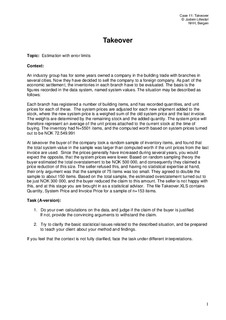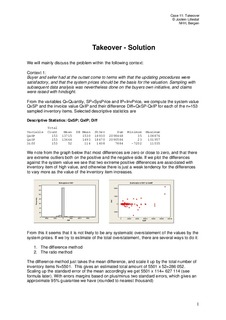| dc.description.abstract | Topic: Estimation with error limits
Context:
An industry group has for some years owned a company in the building trade with branches in several cities. Now they have decided to sell the company to a foreign company. As part of the economic settlement, the inventories in each branch have to be evaluated. The basis is the figures recorded in the data system, named system values. The situation may be described as follows:
Each branch has registered a number of building items, and has recorded quantities, and unit prices for each of these. The system prices are adjusted for each new shipment added to the stock, where the new system price is a weighed sum of the old system price and the last invoice. The weights are determined by the remaining stock and the added quantity. The system price will therefore represent an average of the unit prices attached to the current stock at the time of buying. The inventory had N=5501 items, and the computed worth based on system prices turned out to be NOK 72.549.991
At takeover the buyer of the company took a random sample of inventory items, and found that the total system value in the sample was larger than computed worth if the unit prices from the last invoice are used. Since the prices generally have increased during several years, you would expect the opposite, that the system prices were lower. Based on random sampling theory the buyer estimated the total overstatement to be NOK 500 000, and consequently they claimed a price reduction of this size. The seller refused this, and having no statistical expertise at hand, their only argument was that the sample of 75 items was too small. They agreed to double the sample to about 150 items. Based on the total sample, the estimated overstatement turned out to be just NOK 300 000, and the buyer reduced the claim to this amount. The seller is not happy with this, and at this stage you are brought in as a statistical advisor. The file Takeover.XLS contains Quantity, System Price and Invoice Price for a sample of n=153 items.
Task (A-version):
1. Do your own calculations on the data, and judge if the claim of the buyer is justified.
If not, provide the convincing arguments to withstand the claim.
2. Try to clarify the basic statistical issues related to the described situation, and be prepared
to teach your client about your method and findings.
If you feel that the context is not fully clarified, face the task under different interpretations.
Task (B-version) as above, but with the added guidance:
We may study the problem within two different contexts, leading to slightly different approaches:
Context 1:
Buyer and seller had at the outset come to terms with that the updating procedures were satisfactory, and that the system prices should be the basis for the valuation. Sampling with subsequent data analysis was nevertheless done on the buyers own initiative, and claims were raised with hindsight.
Context 2:
Buyer and seller were at the outset uncertain whether the updating procedure was followed at all branches. They had agreed that possible overstatement of the worth of the inventory using system prices should be fully adjusted. An estimate of this overstatement should be determined by sufficiently large sample.
Here Context 1 corresponds to the actual situation, and may be taken as the primary one.
Statistical issues: Different sampling schemes and different ways of estimating the overstatement and its error margins. The question on how the error margins depend on the sample size.
Some further guidance:
The Difference Method: Estimates where the sample mean of the differences D between system and invoice amounts for each stock item is multiplied by the population size N.
The standard error for estimated overstatement is approximately equal to N S / sqrt(n) under the assumption that the sample is small in comparison with the population (otherwise a so called finite correction may be needed).
(a) Use the difference method to estimate the total overstatement of worth with accompanying error margins corresponding to 95% approximate confidence level.
(b) What sample size will be needed if we want error margins equal +/- 500 000?
Say +/- 300 000?
(c) Search a textbook (or the net) for the Ratio Method as an alternative to the Difference Method.
(d) Search a textbook (or the net) for the following alternative sampling schemes:
(i) stratified sampling (ii) sampling proportional to size | nb_NO |



